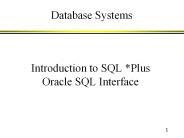Introduction to PL/SQL - PowerPoint PPT Presentation
1 / 25
Title:
Introduction to PL/SQL
Description:
Create PL/SQL decision control structures. Use SQL queries in PL ... FROM table1, table2, ... WHERE join_ conditions. AND search_condition_to_retrieve_1_record; ... – PowerPoint PPT presentation
Number of Views:46
Avg rating:3.0/5.0
Title: Introduction to PL/SQL
1
Introduction to PL/SQL
- Chapter 4
- Lesson B
2
Lesson B Objectives
- Create PL/SQL decision control structures
- Use SQL queries in PL/SQL programs
- Create loops in PL/SQL programs
- Use cursors to retrieve database data into PL/SQL
programs - Use the exception section to handle errors in
PL/SQL programs
3
PL/SQL Decision Control Structures
- Use IF/THEN structure to execute code if
condition is true - IF condition THEN
- commands that execute if condition is TRUE
- END IF
- If condition evaluates to NULL it is considered
false - Use IF/THEN/ELSE to execute code if condition is
true or false - IF condition THEN
- commands that execute if condition is TRUE
- ELSE
- commands that execute if condition is FALSE
- END IF
- Can be nested be sure to end nested statements
4
PL/SQL Decision Control Structures
- Use IF/ELSIF to evaluate many conditions
- IF condition1 THEN
- commands that execute if condition1 is TRUE
- ELSIF condition2 THEN
- commands that execute if condition2 is
TRUE - ELSIF condition3 THEN
- commands that execute if condition3 is
TRUE - ...
- ELSE
- commands that execute if none of the
- conditions are TRUE
- END IF
5
IF/ELSIF Example
6
Complex Conditions
- Created with logical operators AND, OR and NOT
- AND is evaluated before OR
- Use () to set precedence
7
Using SQL Queries in PL/SQL Programs
- Action queries can be used as in SQLPlus
- May use variables in action queries
- DDL commands may not be used in PL/SQL
8
Loops
- Program structure that executes a series of
program statements, and periodically evaluates an
exit condition to determine if the loop should
repeat or exit - Pretest loop evaluates the exit condition before
any program commands execute - Posttest loop executes one or more program
commands before the loop evaluates the exit
condition for the first time - PL/SQL has 5 loop structures
9
The LOOP...EXIT Loop
- LOOP
- program statements
- IF condition THEN
- EXIT
- END IF
- additional program statements
- END LOOP
10
The LOOP...EXIT WHEN Loop
- LOOP
- program statements
- EXIT WHEN condition
- END LOOP
11
The WHILE...LOOP
- WHILE condition LOOP
- program statements
- END LOOP
12
The Numeric FOR Loop
- FOR counter_variable IN start_value .. end_value
- LOOP
- program statements
- END LOOP
13
Cursors
- Pointer to a memory location that the DBMS uses
to process a SQL query - Use to retrieve and manipulate database data
14
Implicit Cursor
15
Using an Implicit Cursor
- Executing a SELECT query creates an implicit
cursor - To retrieve it into a variable use INTO
- SELECT field1, field2, ...
- INTO variable1, variable2, ...
- FROM table1, table2, ...
- WHERE join_ conditions
- AND search_condition_to_retrieve_1_record
- Can only be used with queries that return exactly
one record
16
Explicit Cursor
- Use for queries that return multiple records or
no records - Must be explicitly declared and used
17
Using an Explicit Cursor
- Declare the cursor
- CURSOR cursor_name IS select_query
- Open the cursor
- OPEN cursor_name
- Fetch the data rows
- LOOP
- FETCH cursor_name INTO variable_name(s)
- EXIT WHEN cursor_nameNOTFOUND
- Close the cursor
- CLOSE cursor_name
18
Explicit Cursor with ROWTYPE
19
Cursor FOR Loop
- Automatically opens the cursor, fetches the
records, then closes the cursor - FOR variable_name(s) IN cursor_name LOOP
- processing commands
- END LOOP
- Cursor variables cannot be used outside loop
20
Using Cursor FOR Loop
21
Handling Runtime Errors in PL/SQL Programs
- Runtime errors cause exceptions
- Exception handlers exist to deal with different
error situations - Exceptions cause program control to fall to
exception section where exception is handled
22
Predefined Exceptions
23
Undefined Exceptions
- Less common errors
- Do not have predefined names
- Must declare your own name for the exception code
in the declaration section - DECLARE
- e_exception_name EXCEPTION
- PRAGMA EXCEPTION_INIT(e_exception_name,
- -Oracle_error_code)
24
User-Defined Exceptions
- Not a real Oracle error
- Use to enforce business rules
25
Summary
- PL/SQL is a programming language for working with
an Oracle database - Scalar, composite and reference variables can be
used - The IF/THEN/ELSE decision control structure
allows branching logic - Five loop constructs allow repeating code
- Cursors are returned from queries and can be
explicitly iterated over - Exception handling is performed in the exception
section. User defined exceptions help to enforce
business logic































